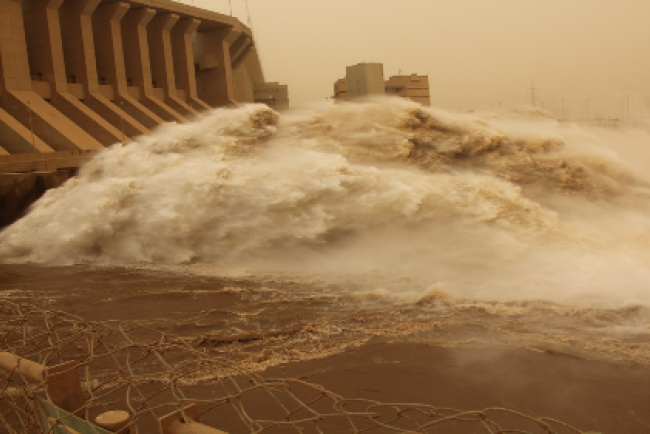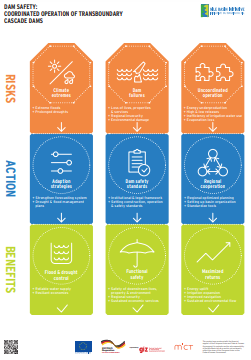
The Eastern Nile sub basin is characterised by rapid population growth, environmental degradation, high rainfall variability and seasonality and frequent natural disasters. The population in the sub basin is projected to increase significantly over the coming decades. Population growth along with improving incomes and expectations will mean a rise in requirements for food, energy, domestic and industrial water. Food supply, energy production and other water delivery services demand sizable, reliable, continuous and efficient supply of water. Furthermore, the demand for water in the midst of unfolding climate change/variability, population and economic growth has increased the need for water storage.
As a result, many dams, particularly medium and small dams are deteriorating, posing a substantial risk to human safety and economic security, with structural and non-structural safety often falling below acceptable international standards. The deterioration of these dams, coupled with increased risk and uncertainty resulting from hydrological variability due to climate change, and uncoordinated operation in the sub basin, has placed many reservoirs at risk.
ENTRO has developed three technical guidelines and roadmaps to guide the Dam Safety and Coordinated Operations of Dam Cascades programme:
- Eastern Nile Reference Dam Safety Guideline
- Small Dam Safety Guidelines
- Dam Safety Training Module
- Roadmap for Coordinated Operation of Cascade Dams
The Dam Safety Capacity Building programme is aimed at improving the capacity of the riparian countries to manage risks related to the safety of dams and downstream communities and address the interdependencies associated with dams in transboundary basins, which may ...
Dam Safety Capacity Building
The Dam Safety Capacity Building programme is aimed at improving the capacity of the riparian countries to manage risks related to the safety of dams and downstream communities and address the interdependencies associated with dams in transboundary basins, which may result in serious impacts across boundaries. Among various factors, dams could be failed by poor planning, design and construction, structural deficiencies, equipment malfunctions, deterioration of structures or equipment due to aging, operational errors, etc. These could cause temporary disruption of critical functions, unsafe releases of water or severe damage to and failure of dams, which would ultimately lead to catastrophic flooding in downstream areas. Hence, it is very important for dam safety assurance to provide for sufficient emergency preparedness and ensure public safety.
The overarching objective of the dam safety programme under the Nile Cooperation for Climate Resilience project is to increase institutionalisation and coordination of dam safety management in the Nile Basin.
In principle, the dam owner is legally responsible for making the dam safe and for operating and maintaining it in a safe condition. The regulator is responsible for protecting the safety of the public by establishing the dam safety regulation and standards with which the dam owner must comply and by monitoring compliance with these standards.
An effective dam safety regulatory framework should:
- Clarify the legal responsibility and liability for dam safety (usually the owner) and the responsibility for monitoring the owner's performance (regulator);
- Specify the owner's responsibilities with regard to the operation and maintenance of the dam and how the owner should review the safety of the dam.
- Explain the ways in which the regulatory authority can perform its monitoring functions, which can include conducting its own inspections, and what powers it has to deal with non-complying dam owners and dams.
The dam safety programme has six components: These are:
- A regulatory review and institutional assessment of dam safety management in the Nile Basin
- Development of a Nile Basin reference dam safety regulatory framework
- Development of a Nile Basin reference dam safety technical guideline for basin wide implementation
- Development of Nile Basin small dam operation and maintenance technical manual and institutional framework
- Development of Nile Basin Reference Guideline on Emergency Action Planning for Dam Incidents and Failures
- Development of implementation strategy and action plan
International experience shows that coordination of the operation of cascade water storage reservoirs has significant contribution for efficient water use, addressing competing and sometimes conflicting water use by different sectors and users and optimisation of the...
Coordinated operation of Cascade Dams: Design Flood Guidelines
International experience shows that coordination of the operation of cascade water storage reservoirs has significant contribution for efficient water use, addressing competing and sometimes conflicting water use by different sectors and users and optimisation of the benefits generated from these storage reservoirs. Through regional cooperation, countries could achieve short and long-term benefits through coordinated operation of existing and planned hydropower facilities. These include boosting of hydropower generated, cooperative flood and drought management, cooperative climate change mitigation and cooperative irrigation development. This approach is believed to facilitate the sustainable development and management of the Eastern Nile shared water resources and provides a range of transformational development benefits across sectors and countries.
The EN has substantial untapped potential for hydropower generation and irrigated agriculture. On the other hand, hydrology of the EN is highly seasonal with over 70 percent of the annual river flow occurring in just four months. As a result, any meaningful utilisation of the water resources of the sub‐basin requires adequate water storage to be put in place. Therefore, there are a number of storage dams in the EN while more are in plan. Dams are operated to release (or store) water to meet specific water demands for which they have been built. While dams in most upstream parts of any river on which they are built depend on the natural inflow of the river, dams located further and further downstream depend also on the controlled releases from upstream dams.
Recognising lack of coordinated reservoir operation framework at sub basin level and that coordinated operation of dams has great potential for enhancing efficient and more optimal use of water, ENTRO has developed a Road Map towards the establishment of coordinated cascade reservoir operation mechanism for Eastern Nile countries.
The Road Map has outlined the key steps countries could take together to develop joint operating rules and accompanying institutional mechanisms for coordinated operation of dams in Eastern Nile.
In line with the Road Map,
- Data collection, processing, modelling (analytic work) and facilitation of stakeholder consultation process conducted.
- Plausible scenarios of coordinated operation of dams (existing and planned) had been generated and prioritised a set of options had been developed.
- A design flood guideline, factoring in climate extremes, to support countries in providing current state of the art practices in design flood analysis for planning new projects and hydrological safety evaluation of existing hydraulic structures is being developed.
In all the above activities, there have been a series of training programmes for policy makers, planners, Water Resource Modellers (National Water Resource Modellers Group), dam owners, dam operators, journalists, etc. focusing on benefits of cooperation on coordinated operation of cascade dams in a transboundary rivers and modelling tools related to coordinated operation of cascade dams at national and transboundary levels.

